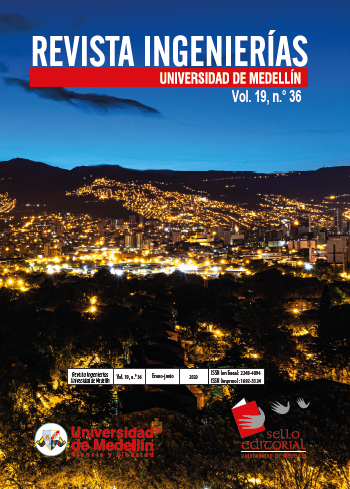Modeling and nonlinear control of volatile fatty acids in an upflow anaerobic fixed bed biofilm reactor (UAFBR)
DOI:
https://doi.org/10.22395/rium.v19n36a3Keywords:
volatile fatty acids (AGV);, bio-gas; bioreactor, chemical oxygen demand, anaerobic digestion, nonlinear control, digesting modelAbstract
In this article a robust regulation strategy of volatile fatty acids is proposed by an anaerobic digestion process. The proposed strategy is a control law via nonlinear feedback obtained by input-output linearization that allows the completion of the control goals despite the modeling errors (uncertainties in the kinetics of the reactions) and the actuator restrictions. The experiments were conducted with an pilot fixed anaerobic reactor and ascending flow (UAFBR) with an active volume of 0.947 m3 fully equipped, used for the treatment of residual waters coming from a wine distillery in Narbonne, France. With the goal of validating the models used, simulated and experimental results are presented and discussed. The performance parameters of the controller under the AM2 and ADM1 models (up time, establishment time, over-impulse and stationary state error) obtained from the numeric simulations that prove the efficiency and applicability of the proposed control strategy.
Downloads
References
[1] A. Mottet, I. RamÃrez, H. Carrère, S. Déléris, F. Vedrenne, J. Jimenez, y J.P. Steyer, “New fractionation for a better bioaccessibility description of particulate organic matter in a modified ADM1 modelâ€, Chemical Engineering Journal, [En lÃnea], vol. 228, pp. 871-881, 2013. DOI: 10.1016/j.cej.2013.05.082
[2] I. RamÃrez, “Anaerobic digestion modelling: from one to several bacterial populationsâ€, Revista TecnoLógicas , [En lÃnea], vol. 31, pp. 181-201, 2013.
[3] M. Henze, P. Harremos, J. LA Cour Jansen, y E. Arvin, Wastewater Treatment: Biological and Chemical Process, 3.a ed. Springer Science and Business Media, 2001.
[4] D.M. Revelo, N.H. Hurtado, y J.O. Ruiz, “Microbial Fuel Cells (MFCS): a challenge for the removal of organic matter and electricity generationâ€, Información tecnológica, [En lÃnea], vol. 24, n.° 6, 2013. DOI:10.4067/S0718-07642013000600004
[5] J.P. Steyer, O. Bernard, D.J. Batstone, y I. Angelidaki. “Lessons learnt from 15 years of ICA in anaerobic digestersâ€, Water Science and Technology, [En lÃnea], vol. 53, n.° 4, pp. 25-33, 2006. DOI: 10.2166/wst.2006.107
[6] D.J. Batstone, J. Keller, I. Angelidaki, S. Kalyuzhnyi, S.G. Pavlostathis, A. Rozzi, y V.A. Vavilin. “The IWA anaerobic digestion model no 1 (ADM1)â€, Water Science and Technology, [En lÃnea], vol. 45, n.° 10, pp. 65-73, 2002. DOI: 10.2166/wst.2002.0292
[7] O. Bernard, Z. Hadj-Sadok, D. Dochain, A. Genovesi, y J.P. Steyer, “Dynamical model development and parameter identification for an anaerobic wastewater treatment processâ€, Biotechnology and Bioengineering, [En lÃnea], vol. 75, n.° 4, pp. 424-438, 2001. DOI: 10.1002/bit.10036
[8] S. GarcÃa-Gen, J.M. Lema, y J. RodrÃguez. “ADM1 application to anaerobic co-digestion: generalised implementation of fermentable soluble substratesâ€, Presentado en the 13th world congress on Anaerobic Digestion. Santiago de Compostela, Spain, 2013. DOI: 10.1016/j.biortech.2013.08.063
[9] H.O. Méndez-Acosta, B. Palacios-Ruiz, J.P. Steyer, V. Alcaraz-Gonzáles, E. Latrille, y V. Gonzáles-Alvarez. “Nonlinear approach for the VFA regulation in an anaerobic digesterâ€, en 10th International IFAC Symposium on Computer Applications in Biotechnology, 2007. DOI: 10.3182/20070604-3-MX-2914.00015
[10] D. Selisteanu, E. Petre, y V.B. Rasvan, “Sliding mode and adaptative sliding-mod control of a class of nonlinear bioprocessesâ€, International Journal of Adaptive Control and Signal Processing, [En lÃnea], vol. 21, pp. 795-822, 2007. DOI: 10.1002/acs.973
[11] C. Kravaris, y G. Savoglidis, “Tracking the singular arc of a continuous bioreactor using sliding mode control.†Journal of the Franklin Institute, vol. 349, n° 4, pp. 1583-1601, 2012. DOI: 10.1016/j.jfranklin.2011.06.011
[12] M.R.S. Khan, y R.N.K. Loh, “Nonlinear Control of Bioprocess Using Feedback Linea-rization, Backstepping, and Luenberger Observersâ€, International Journal of Modern Nonlinear Theory and Application, [En lÃnea], vol. 3, n.° 4, pp. 150-162, 2014. DOI: 10.4236/ijmnta.2014.34017
[13] I. Ramirez, “Integrating Biotechnology and Microbial Ecology in Bioprocesses Controlâ€, International Journal of Emerging Technology and Advanced Engineering, vol. 8, n.° 5, 2018.
[14] I. Ramirez, “Experimental and modeling investigations of an up-flow anaerobic fixed bed reactor (UAFBR)â€, Environmental Biotechnology Laboratory, INRA, Narbonne-France, Tech. Rep. LBE-006-69-3, [En lÃnea], p. 160, Abr. 2010. DOI: 10.2166/wst.2008.342
[15] I. Ramirez, y J.P. Steyer, “Modeling microbial diversity in anaerobic digestionâ€, Water Science and Technology, [En lÃnea], vol. 57, n.° 2, pp. 265-270, 2008. DOI: 10.2166/wst.2008.055
Downloads
Published
How to Cite
Issue
Section
License
The total or partial reproduction of the contents of the journal for educational, research, or academic purposes is authorized as long as the source is cited. For reproduction for other purposes, express authorization from the Sello Editorial Universidad de MedellÃn is required.

